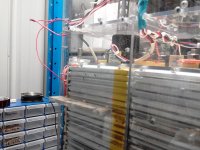Well it's been almost a year since I last touched the bike. The ride to Mundaring was the last ride it did on this battery before being parked up and having nowhere to go.
The battery had a short, hard life, so I was not expecting it to be in good shape. Considering I built this one in 2015 (go back a page or three to see the build) and we raced it for a couple of seasons, it's done OK.
But I plugged it on to charge it and it wasn't having a bar of it. I figured one of the modules wasn't in good shape, so it was time to hoist the pack out and measure some cell voltages.
Most cells were around 2.8 V (as good as empty) but quite a few were closer to 2 V or less. It's been neglected for some time, and I'm pretty sure the BMS takes a bit from the cells too. Meanwhile, another group of cells was still sitting at 4 V! Dread to think what this group got to after charging all the way up to 700 V

The BMS never balanced, only monitored. And it had been telling me for some time this group was not much chop. So regardless, this was a badly out of shape pack. Ah well, off to the recycling gods you go

However, the reason it was not charging became apparent shortly after starting to disassemble the pack.

This pack was built as the last battery I ever soldered busbars to. And here is why solder is generally a bad idea. The main terminal on this module (and one around the other side) was disconnected from the pad. As the cells swelled and distorted a bit, it left constant tension on the soldered joint. In the end, it just failed and popped off. Nowadays I use screws and they have never had this problem. Good move.
I figured the pack was swollen a bit (it's perfectly normal for pouches to swell) so I started to pull the pack apart. Several screws were quite tough and the heads chewed out, so I Dremmeled a slot in them so I could undo them. As soon as I relieved the tension, the top shelf lifted upwards about 10 or 12 mm due to pressure from the cells below.

I remember someone asking about 5 or 7 years ago whether or not there was enough compression on the cells inside the polycarbonate enclosure. The answer was yes. The polycarbonate enclosure did a very good job of keeping the cells under compression.
So it's time to design and build a new pack!
I'm thinking of using the 7000 mAh cells I used in the Prelude, and maybe making it a 168s3p pack so I have 21 Ah. It won't be a very powerful battery, but with 13 kWh, it will certainly have more range. These particular cells might be good for 4 or 5 C discharge, but still, that's barely 100 amps at 650 V. I feel like a bike needs at least 15 C capable cells. I think there were some 175 Wh/kg cells in that realm. Or I can go back to the usual LiPo cells I normally use and build another 6 or 7 kWh pack. It will have plenty of power that way.
I might use aluminium instead of polycarb for the enclosure. Provided I can insulate it appropriately it should be OK. While I'm there I might as well re-do much of the wiring loom. You can always do a better job





